As Mars reaches opposition, watch as the full Moon occults the Red Planet!
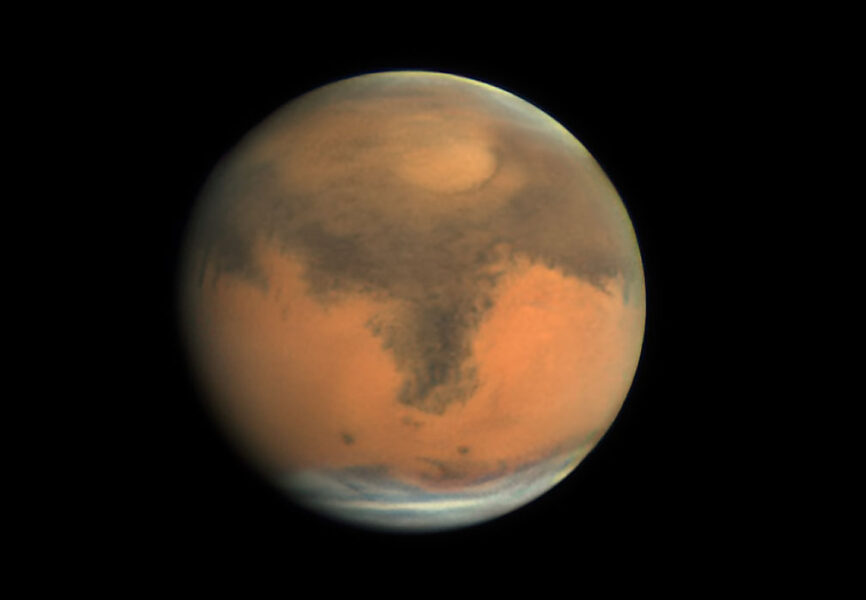
Damian Peach
Like that back-ordered telescope we've been waiting months to receive, the truck has finally arrived and delivered Mars to our doorstep. Impressively bright at magnitude –1.8, it rises in Taurus in the scintillating company of the Winter Hexagon gang. Despite this not being a particularly close opposition, the Red Planet sails high in the sky, where improved better atmospheric seeing helps to compensate for its relatively small apparent diameter.
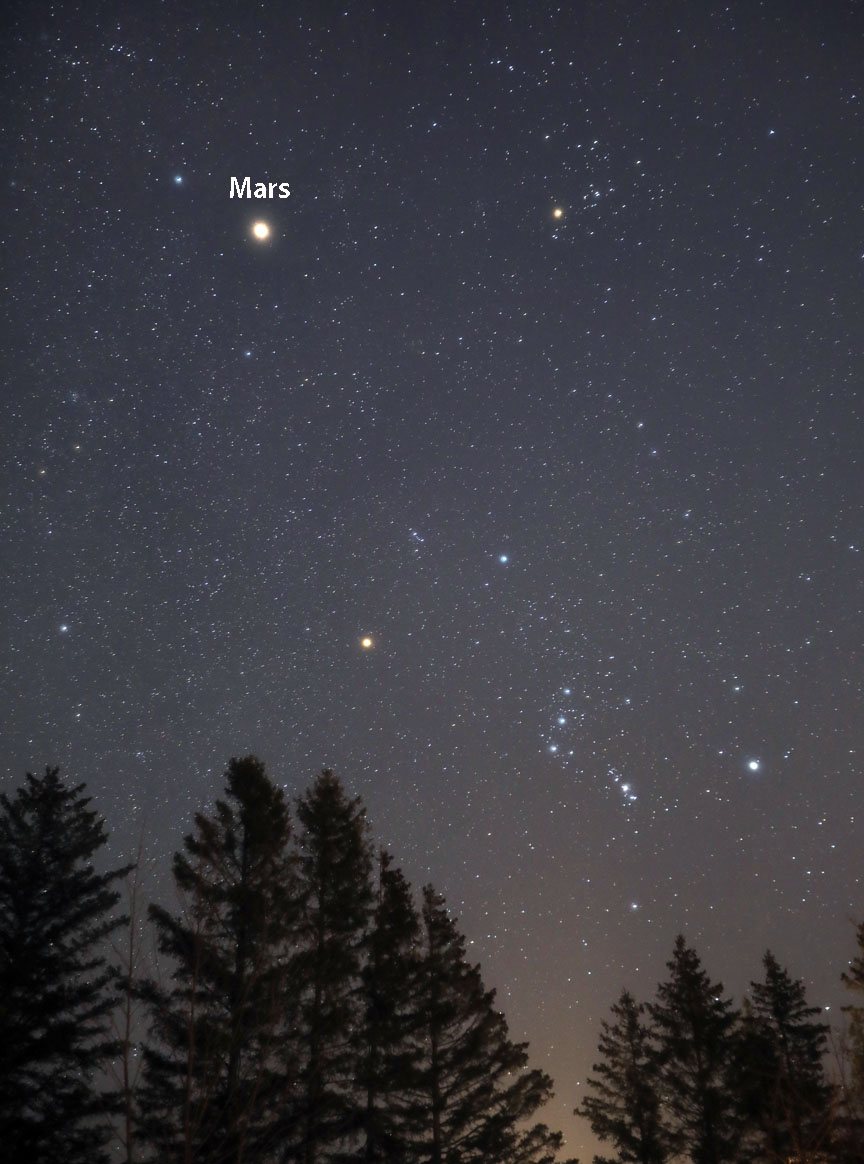
Bob King
Although Mars reaches opposition on December 8th (December 7th in the Americas), it's closest to Earth a week earlier on December 1st at 2:18 UT when the two planets will sit just 81.45 million kilometers (50.61 million miles) apart. The two dates don't coincide because Mars's elliptical orbit further removes the planet from Earth even as we catch up to join it at opposition. Three remote — or aphelic — oppositions follow this one (in 2025, 2027, and 2029) before the Earth and Mars line up nearly as close again (82.8 million km) in May 2031.
One Step Backward . . .
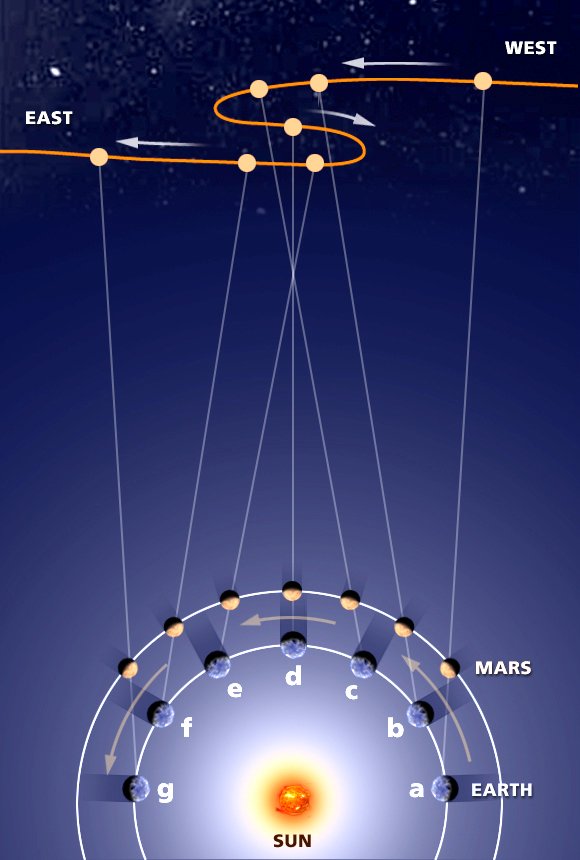
NASA
In early December, we find the Red Planet midway along its retrograde loop, moving west across Taurus as the faster Earth prepares to lap it at opposition. Mars rises near sunset and climbs high enough by 9 p.m. local time for a look through the telescope. Of all the planets it's the only one with a plainly visible surface. But unlike soft-touch Jupiter with its gaudy cloud bands or the gimme of Saturn's rings, Mars keeps its secrets close. Teasing out its low-contrast albedo features requires an equal mix of determination and good atmospheric seeing.
Choosing the Right Filter

Bob King
I have a 10-inch Dobsonian that I can set up at a moment's notice to check on the Red Planet every clear night. If the disk displays a sharp edge (a rarity!) I immediately employ 286× to look for dark features, clouds, and potential dust storms. When the seeing gods allow I occasionally observe at 357× and even 400×. My favorite tool besides high magnification is a red 23A filter. Red penetrates the planet's hazy atmosphere and better shows the albedo features. It also tames the Martian glare and settles the image. On a good night I'll spend about an hour studying the planet. A blue filter is also handy for discerning water-ice clouds and limb hazes. Although there are no current regional or larger dust storms that would block or blur the surface they can blow up almost anytime. Orange and red filters help to sharpen their outlines and increase contrast.
Start with Syrtis
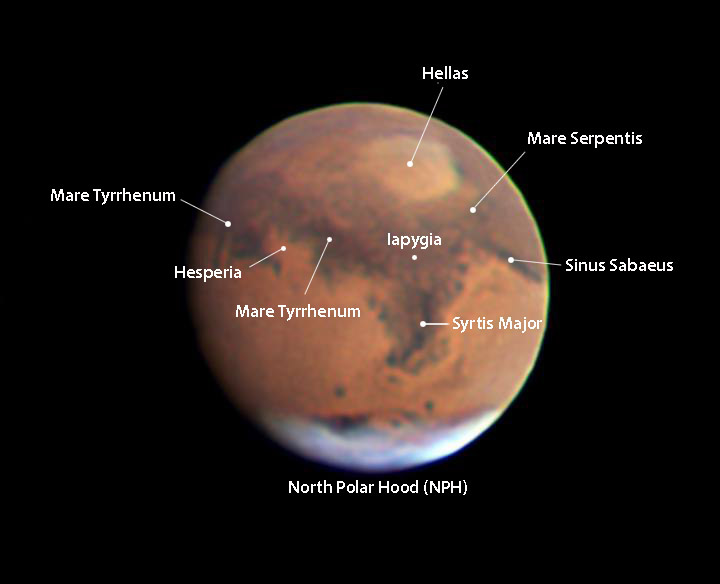
Gregg Hallinan
Fortunately, observers across the Americas can begin their Martian explorations at Syrtis Major (Gulf of Sidra), a low-lying shield volcano shaped like the Indian subcontinent. Few albedo markings are as large, dark and well-positioned as this one. And it will be squarely in view during the first few nights of December, near the central meridian (CM) — an imaginary north-to-south line passing through the planet's center — around 11 p.m. EST. NASA's Mars Perseverance rover landed in Jezero Crater at the northwestern tip of Syrtis Major in search of clues and possible traces of past life. In recent months, it discovered a trove of organic-rich material in the crater's ancient delta.
From Syrtis Major a pair of dark "arms"— Mare Serpentis (Sea of Serpents) and the stick-like Sinus Sabaeus (Bay of Sheba and pronounced SEE-nuss, sa-BEE-us) — form a broad, tilted "Y" to its southeast and east, respectively. Southwest of Syrtis Major look for the thick and muscular form of Mare Tyrrhenum (Tyrrhenian Sea, Ter-RAIN-num), a heavily cratered highland region.

Damian Peach / Gregg Dinderman / S&T
Moving south, Syrtis Major blends into the dark, cratered highlands of Iapygia (Salento, the heel of Italy's "boot," eye-uh-PIJ-ee-uh), which is topped by the bright oval of Hellas (Greece). At 2,300 kilometers across and more than 7 kilometers deep Hellas is the largest impact basin on Mars. South of Hellas and currently small and out of view lies the remnant South Polar Cap. Right now, it's late summer in the planet's southern hemisphere when the cap reaches its smallest extent. Adding to the difficulty, Mars's south polar axis nods just 3.5° in our direction in early December. These two factors place the remaining cap at or just beyond the southern limb. Later in January, when the tip increases to 9°, astrophotographers may have success in recovering it.
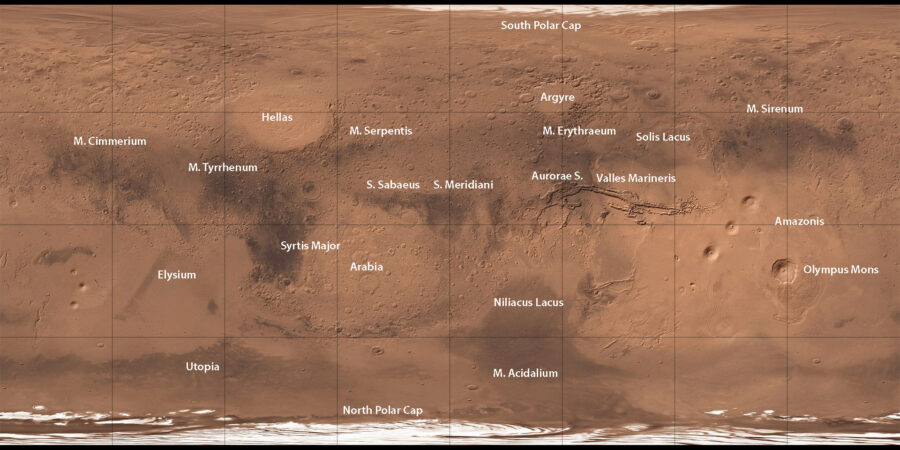
NASA / USGS
Martian Hoodie
We can't see the North Polar Cap (NPC) either. At least for now. For the past few months, a hood of dense, bright clouds, the North Polar Hood (NPH), has cloaked the region. Water and CO2 snow falling from the clouds are fattening up the NPC, which should return to view in mid-January as spring unfolds in the northern hemisphere, and the hood begins to dissipate. Aside from Syrtis Major, the NPH is probably the single easiest feature to spot on Mars, forming a thick white rim along the planet's northern limb.
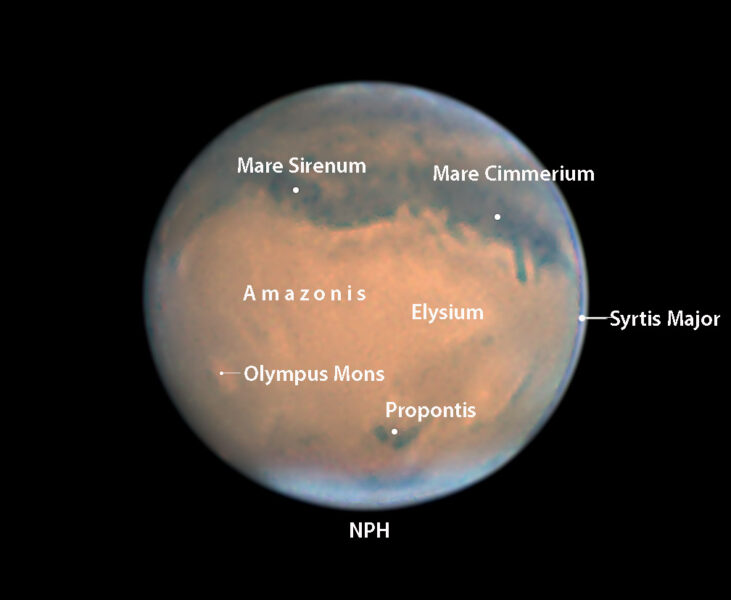
Anthony Wesley
Continuing west from Mare Tyrrhenum we encounter a light-toned, diagonal gap, Hesperia (Land of the Setting Sun) followed by the prominent band of Mare Cimmerium (Cimmerium Sea). Cimmerium, known for its water-carved gullies, merges into Mare Sirenum (Sea of Sirens, sih-REE-num), creating a long, festoon-like sash across the planet's southern hemisphere. The vast, smooth plains of Elysium (Greek resting place of heroes) and Amazonis (Land of the Amazon) fill out much of the northern hemisphere, the western portion of which is dominated by ancient volcanoes including Olympus Mons, the largest in the solar system.
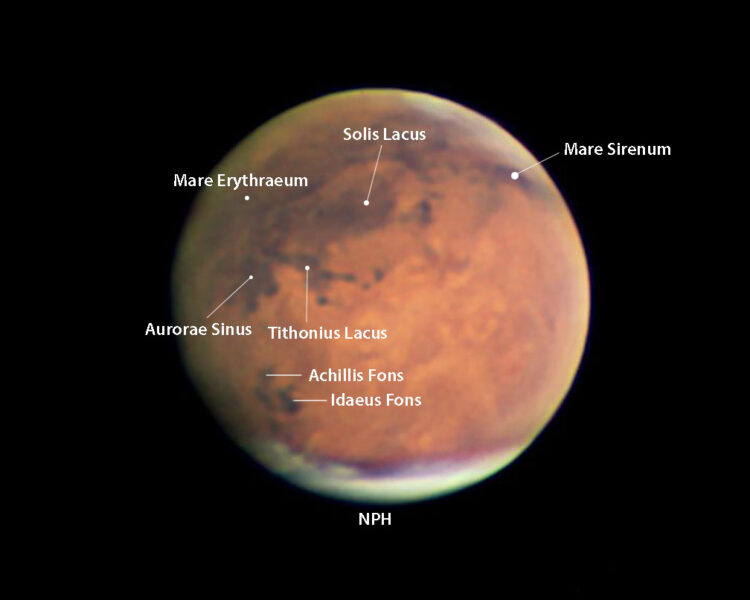
Gregg Hallinan
Watchful eye
Continuing west the planet offers up a great variety of dark markings including Solis Lacus (Lake of the Sun), once called "Oculus" because it resembles a giant, unblinking eye. This region is famous for dust storms, which can cause the feature's shape and contrast to vary at each opposition. Be sure to spend a few minutes looking for a skinny, twig-like extension north of Solis Lacus called Tithonius Lacus (Tithonian Lake). Together with the trilobed Aurorae Sinus (Bay of the Dawn) these dark smudges define the largest canyon system in the solar system — Valles Marineris. For all its visual fragility I get a thrill every time I see it. Mare Erythraeum (Red Sea, air-eh-THREE-um) is a mottled, expansive region that occupies a significant portion of the planet's southern hemisphere. The 1,800-kilometer-wide Argyre impact basin lies along its southern border.
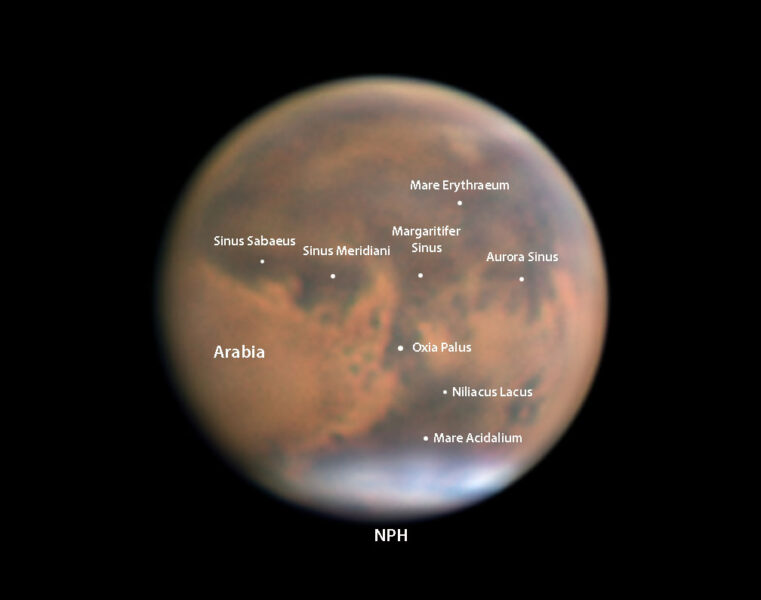
Efrain Morales
Blueberry pie, anyone?
We wrap our quick review of Mars with a very busy hemisphere that includes the aptly named Sinus Meridiani (Meridian Bay), marking the location of the Martian prime (0°) meridian. Meridiani is also famous for its "blueberries," hematite-rich spherules about 0.3 cm (1/8-inch) across that likely formed in the presence of water. They litter the surface like confetti after a Times Square New Year's celebration. Together with Sinus Sabaeus, Sinus Meridiani forms a distinctive club-shaped marking that reminds me of a turkey drumstick.
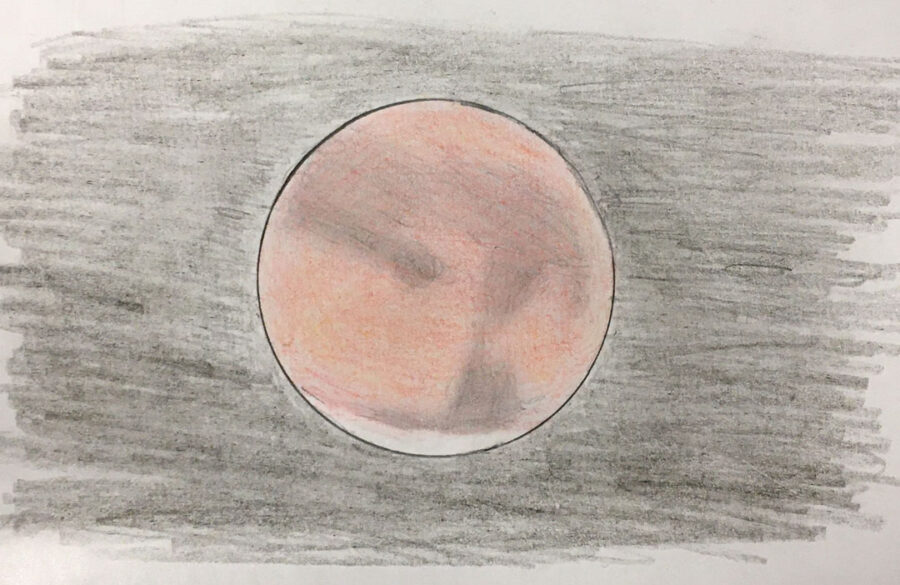
Bob King
Farther east you'll find Margaritifer Sinus (Pearl-bearing Bay), a wispy, triangular patch we know to be rich in clay with abundant evidence of lakes, deltas, and ancient rivers. Oxia Palus (Oxeia Marsh) joins it to Niliacus Lacus / Mare Acidalium, which merge to form a prominent dark patch shaped like a tree stump extending south from the pearly clouds of the NPH.

Stellarium
You can know what's up on the Red Planet anytime by using Sky & Telescope's Mars Profiler. Just type in a time and find out what's crossing the central meridian at the moment. You can also download the Mars Atlas app for iPhone or Mars Atlas for Android. Don't have a telescope? Astronomer Gianluca Masi will live-stream close-up views of Mars on his Virtual Telescope site starting at 3 p.m. EST (20:00 UT), Nov. 30.
Moon Occults Mars on December 7–8
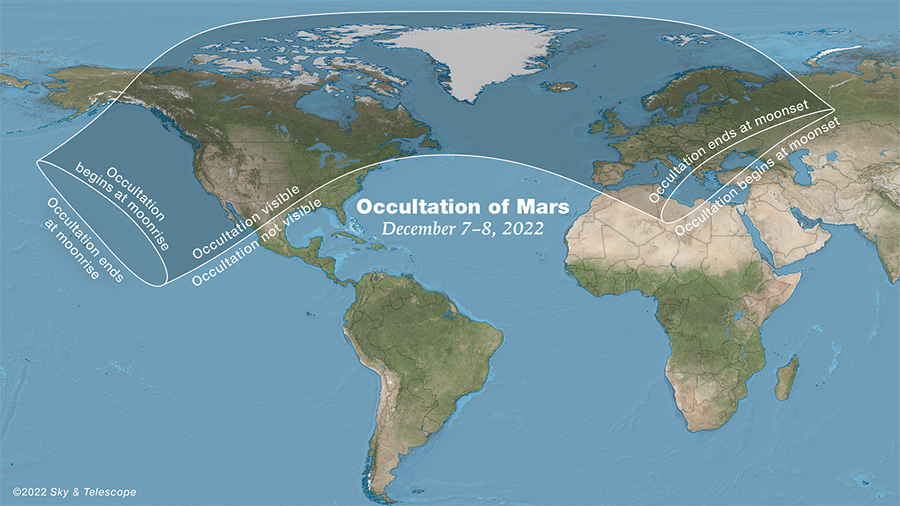
Gregg Dinderman / Sky & Telescope
As if opposition weren't enough, the full Cold Moon will occult Mars for much of the North America (except the Southeast and a section of the East Coast), Greenland, and Europe on December 7–8. Even if you're not in the occultation zone, you'll still see an extremely close conjunction between two of the brightest bodies in the night sky. As the time of occultation approaches, the Moon will edge its way toward Mars and then slowly devour the Red Planet by degrees, taking many seconds to completely cover it. Depending on your location, Mars will go missing for minutes to more than an hour until it returns to view at the opposite limb, making for an equally astounding sight.
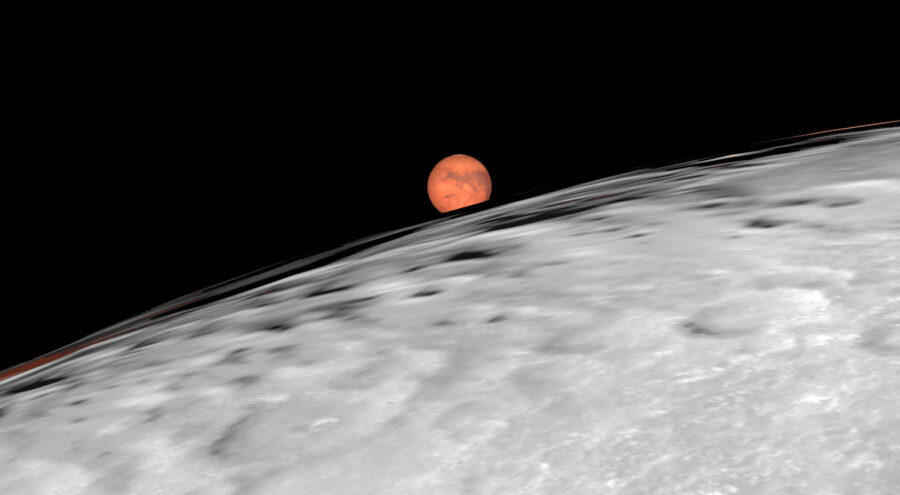
Stellarium with additions by Bob King
I'm really curious if we'll continue to see Mars with the naked eye right up to the Moon's edge. I suspect we will. Also, at what point will the planet disappear from view as it dips behind the Moon? Keep those binoculars handy! Telescopic observers will get fabulous views, especially those living within the southern graze zone, where the Moon will partially occult the planet (see below).
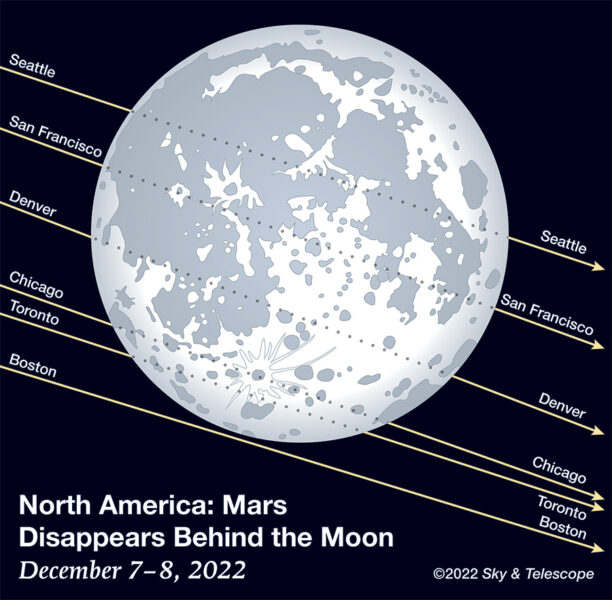
Gregg Dinderman / Sky & Telescope
For full details, see pages 48–49 in the December 2022 issue of Sky & Telescope magazine or check out the International Occultation Timing Association's (IOTA) page devoted to the event. All times are UT, so remember to subtract 5 hours for EST; 6 for CST; 7 for MST; and 8 for PST.
I hope you observe Mars often enough to feel comfortable navigating the planet just like a real Martian.
 11
11
Comments
Rod
November 30, 2022 at 9:24 pm
I posted a Mars observation report here tonight, https://skyandtelescope.org/astronomy-news/this-weeks-sky-at-a-glance-november-25-december-3-2/#comment-385680
Windy though, WNW 16 knots so some bouncing views of Mars in the telescope 🙂
You must be logged in to post a comment.
Bob KingPost Author
December 1, 2022 at 12:48 am
Thanks, Rod for sharing your observation. My night was similar — windy! Got great views of the "steer skull" of Syrtis Major, Mare Tyrrhenum and Mare Serpentis. I'm eager for the first glimpses of the North Polar Cap.
You must be logged in to post a comment.
Rod
December 1, 2022 at 7:01 am
Very good Bob. I used my 90-mm refractor on an alt-azimuth tripod, dovetail plate with tube rings holding the telescope in place. When the wind hit the telescope, it bounced the image of Mars like a bouncing ball at times 🙂 Syrtis Major at 129x with red filter during steady views was nice. I good see the dark shape on right side (mirror reverse view) with a thin finger pointing up or north with brighter Hellas area below. I have my 10-inch Newtonian Dob mounted telescope I could use on 07-Dec/08-Dec but presently, mostly cloudy skies forecasted. I plan to be patient and see what develops. Hope you get some great views of the Moon close to Mars or occulting at your location.
You must be logged in to post a comment.
Chris-Schur
December 3, 2022 at 5:11 pm
Thank you for this informative article Bob! I was inspired by your article to get out and try to shoot those polar clouds, something I have never imaged. Not only did I get this feature, but I also saw clouds on the limb as well. This was fantastic! Cant wait now for that lunar occultation.
You must be logged in to post a comment.
Bob KingPost Author
December 4, 2022 at 3:51 pm
Hi Chris,
Thanks! Inspiration is what much of life is about. I'm tickled you not only saw the hood but also limb clouds. Those can really stand out sometimes especially with a blue or violet filter. I have a deep #47 filter that really alters the planet's appearance from the norm.
You must be logged in to post a comment.
Rod
December 4, 2022 at 9:39 pm
I placed another Mars observation note for tonight, https://skyandtelescope.org/astronomy-news/observing-news/this-weeks-sky-at-a-glance-december-2-10-2/
I may have some mostly cloudy skies coming for 07-08 December. Tonight, was very good viewing.
You must be logged in to post a comment.
Bob KingPost Author
December 5, 2022 at 11:55 am
Thanks for posting your observations, Rod. I hope others are taking advantage of an excellent Mars this apparition. I was out last night (Dec. 5.2 UT) with my 10-inch and finally got to see beyond Syrtis Major to its (celestial) west for excellent views of Mare Tyrrhenum, Mare Hadriacum, the "gap" of Hesperia and part of M. Cimmerium. With much concentration in the best moments of seeing I caught sight of Nodus Alcyonius poking south out of the North Polar Hood. I only wish I could do something about the abundant floaters in my observing eye that become very apparent at high magnifications (small exit pupils).
You must be logged in to post a comment.
Rod
December 7, 2022 at 10:54 pm
I did see some of the Moon and Mars conjunction tonight. Overcast and soupy skies 🙂
Observed 2100-2235 EST/0200-0335 UT 08-Dec-2022. Full Moon 08-Dec-2022 0408 UT. I did briefly see the Moon and Mars close together using 10x50 binoculars. The cloud cover was soup and only a few breaks allowed me to see both. Stellarium 1.1 shows the Moon and Mars near 2115 EST < 30-arcminute angular separation. For my location, no lunar occultation of Mars but the two will be a bit closer than 2 arcminute angular separation near 2246 EST. Some light rain earlier today and overcast and cloudy this evening. 2222 EST, clouds thinning, and I could see the Moon and Mars just less than 5 arcminute angular separation using 10x50 binoculars. 2235 EST, overcast still but some thinning. I did see the Moon and Mars less than 3 arcminute apart using my 10x50 binoculars. Overcast soup continued so I went inside. At least I observed some of the Moon and Mars close together tonight but only brief views through the overcast skies.
You must be logged in to post a comment.
Bob KingPost Author
December 8, 2022 at 11:26 am
Hi Rod,
Glad you got to see them up close! I had to travel a few miles (not far) for clear skies. I thought it might be possible to see Mars right up until it touched the lunar limb, but I was only able to keep the planet in view with the naked eye 9 minutes before the occultation when it was 3.5' from the lunar limb. After that I lost it. Binoculars showed it pinned to the moon's edge. My favorite moment was seeing Mars "rise" at the opposite limb. It was just a beautiful sight and seemed to happen so quickly.
You must be logged in to post a comment.
Chris-Dalla Piazza
December 8, 2022 at 12:32 am
Got to see the grazing occultation even with competition from clouds.
As the disappearance time approached we weren’t sure if it would be a near miss. We kept getting glimpses so it was hard to know. At one point Mars disappeared from view perfectly touching the lunar limb without any shadowed lunar limb in profile. I thought for sure we were right on the edge of the grazing occultation and that was it as the disappearance time was a bit past.
After a few moments another break in the clouds rolled past with a brief view of Mars half covered and a hairline of shadowed lunar limb in profile. Again I was sure that was the last of it as an unbroken bank of clouds rolled in. My wife departed to turn in for the night but I stuck it out just to be sure and at least catch some more views of Mars near the moon.
Wrong again! Then the real show started. The moon jumped out of the clouds after what seemed like an implausible long time… but with no Mars. Then I finally found about 1/8 of Mars still poking above the lunar limb.
Freshly recalled from the house my wife and I watched mostly uninterrupted as hills and crater rims slid past Mars. There were times both illuminated limb and shadowed limb touched Mars simultaneously.
It began to dawn on me how unique this observation was. I’ve observed occultations before but certainly never over a span of time like this. Also never with obliquely illuminated lunar limb in proximity. Usually the planet just gets covered up by darkness… still neat… but not with a view over the edge of the moon to lend perspective.
Even after Mars separated from the limb we watched for awhile just to take in that Mars rise over the moon effect. I think the clouds actually helped the seeing a bit because it was decently steady. I also believe Mars never got completely covered from our location. A real treat!
You must be logged in to post a comment.
Bob KingPost Author
December 8, 2022 at 11:28 am
Hi Chris,
Great report! It goes to show how that no matter how many different types of occultations one might see in a lifetime, circumstances differ enough to make each unique, this one especially so for you and your wife.
You must be logged in to post a comment.
You must be logged in to post a comment.